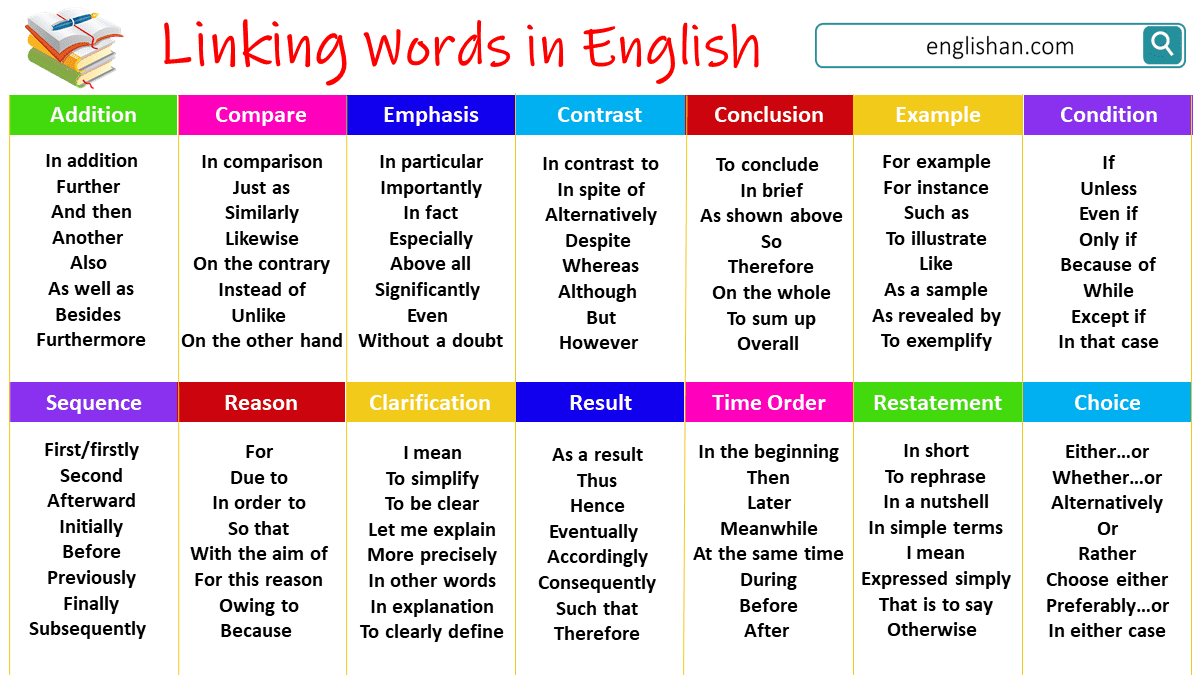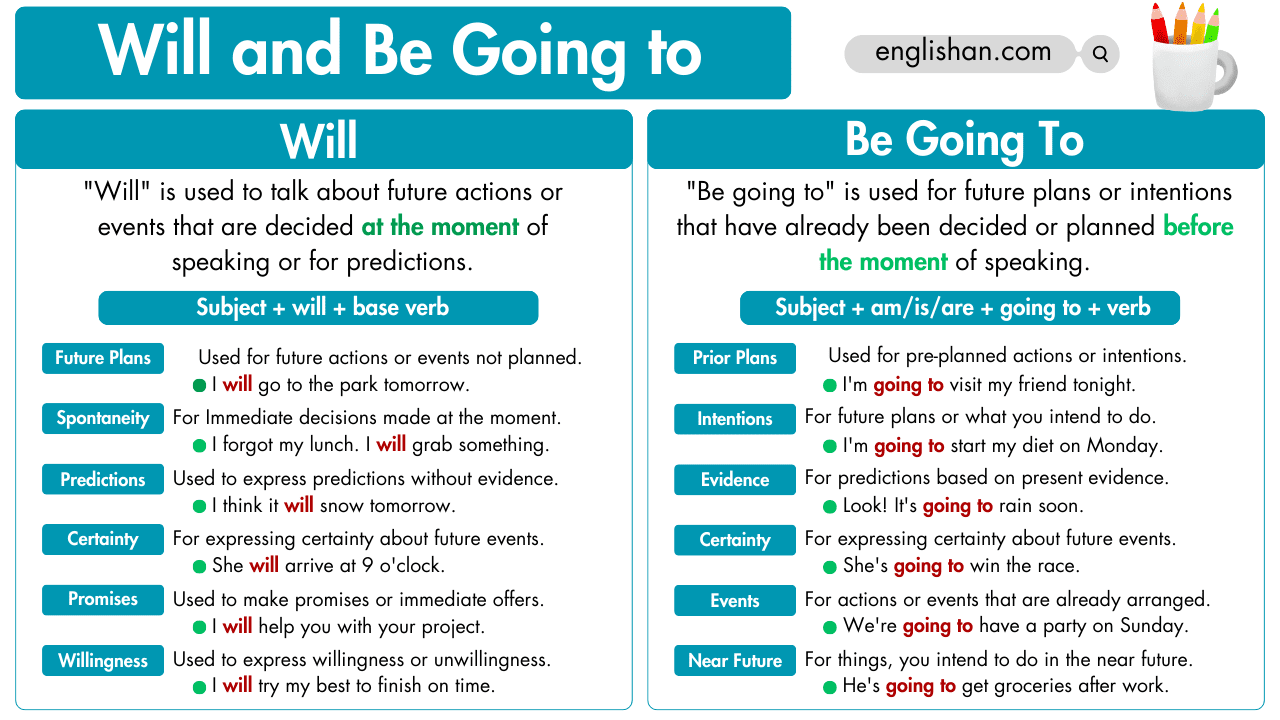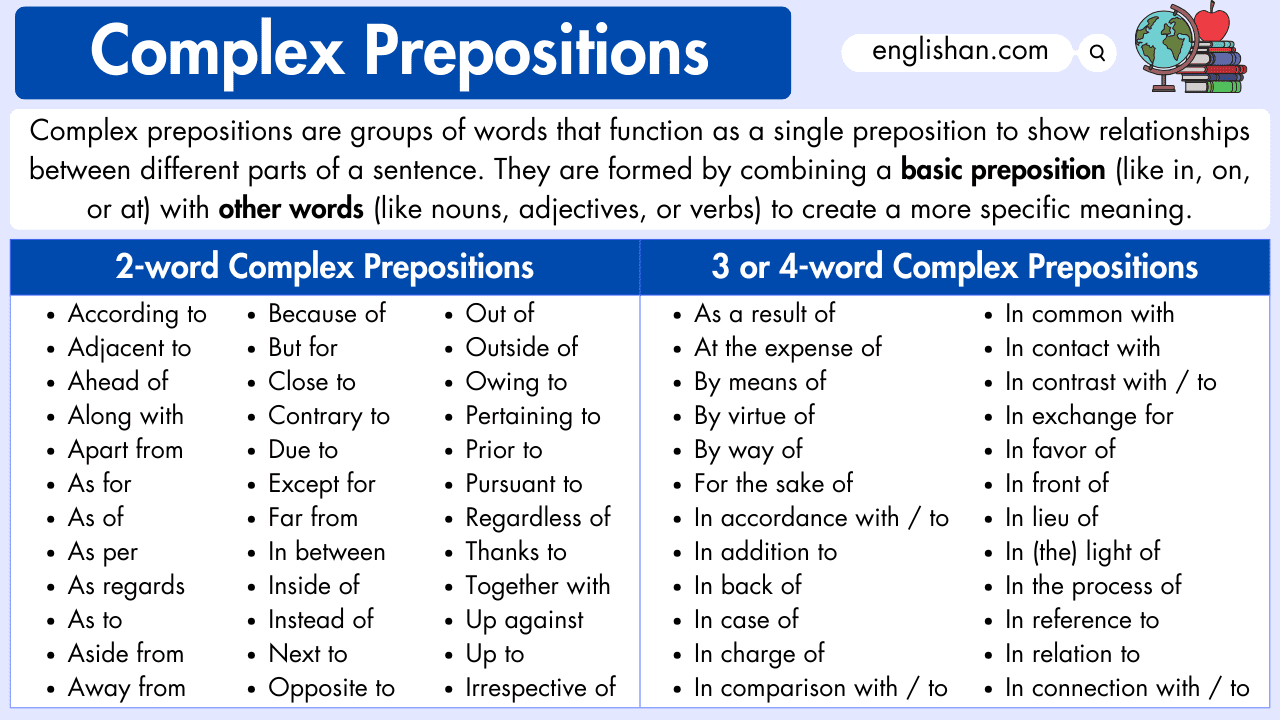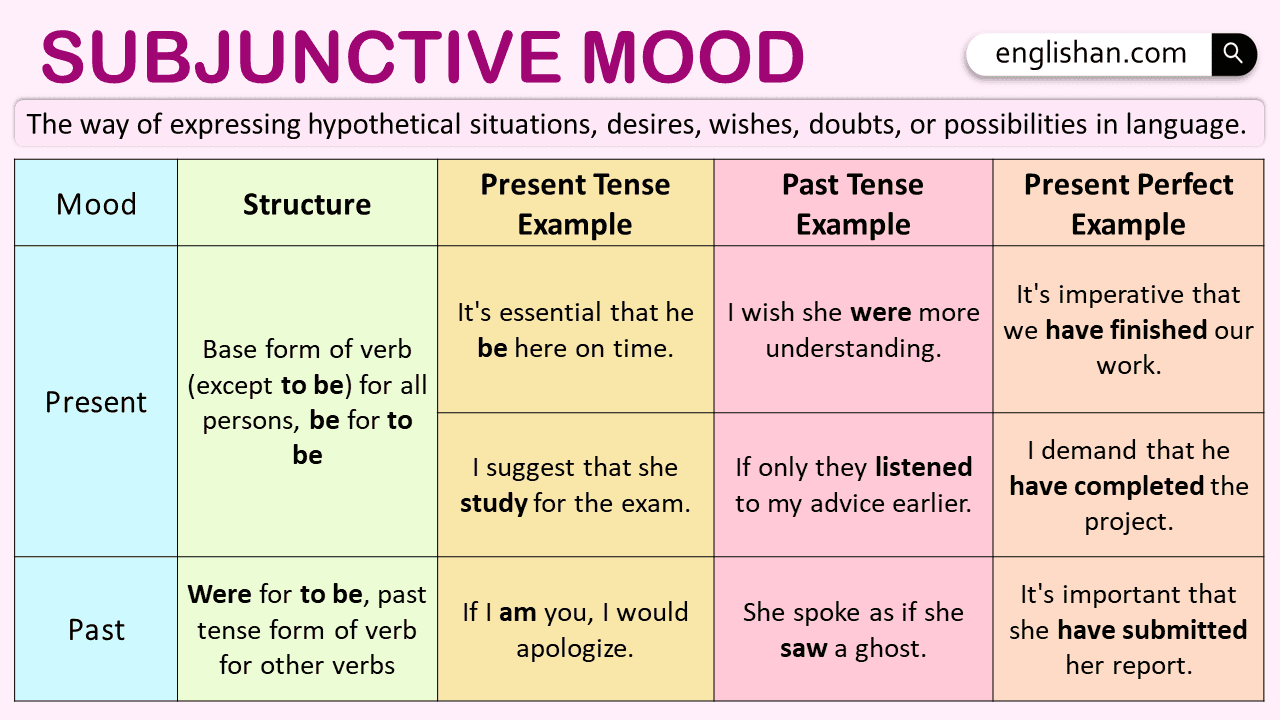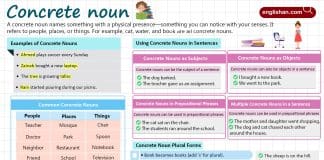Contents
In this article, you will learn about types of verbs, their forms, uses, and functions, with examples for each.
A verb describes an action, occurrence, or state of being. It is often called a “doing” word because it tells what the subject of the sentence is doing or experiencing.
Examples:
- Action: “She walks to the store.” (The verb “walks” shows what she is doing.)
- State: “He is happy.” (The verb “is” shows his state of being.)
Verbs can show tense (when an action happens: past, present, or future), mood (the speaker’s attitude: indicative, imperative, subjunctive), and voice (whether the subject performs or receives the action: active or passive).
Verbs form the main part of a sentence’s predicate and are essential to sentence structure.
Common Types of Verbs
- Action Verbs
- Linking Verbs
- Auxiliary (Helping) Verbs
- Modal Verbs
- Transitive Verbs
- Intransitive Verbs
- Phrasal Verbs
- Stative Verbs
There are several types of verbs in English, including:
Types of Verbs and Their Examples
Action Verb
An action verb describes a physical or mental action performed by the subject in a sentence. It shows what the subject is doing, such as “run,” “walk,” “jump,” “eat,” “think,” or “play.”
Action verbs can appear in different tenses:
- Present: “I run every day.”
- Past: “I ran yesterday.”
- Future: “I will run tomorrow.”
Action verbs can be transitive or intransitive:
- Transitive: Followed by a direct object. Example: “I ate an apple” (apple is the object).
- Intransitive: No direct object. Example: “He laughed.”
Understanding action verbs helps clarify who is performing the action and what the action involves.
Linking Verbs
Linking verbs connect the subject of a sentence to a state, condition, or identity, rather than showing action. They link the subject to a predicate or a subject complement. Common linking verbs include “be,” “appear,” “seem,” “become,” “feel,” “look,” “sound,” and “taste.”
Examples:
- She looks happy. (“Looks” connects “she” to the adjective “happy.”)
- The cake smells delicious. (“Smells” connects “the cake” to “delicious.”)
- He became a doctor. (“Became” connects “he” to “a doctor.”)
Here is a list of common linking verbs:
- am, is, are, was, were, be, being, been
- become, seem, appear, look, feel, taste, smell, sound
- remain, grow, turn, stay, prove, get, go, keep, run, stand, lie, sit
These verbs help describe a subject’s state or identity instead of an action.
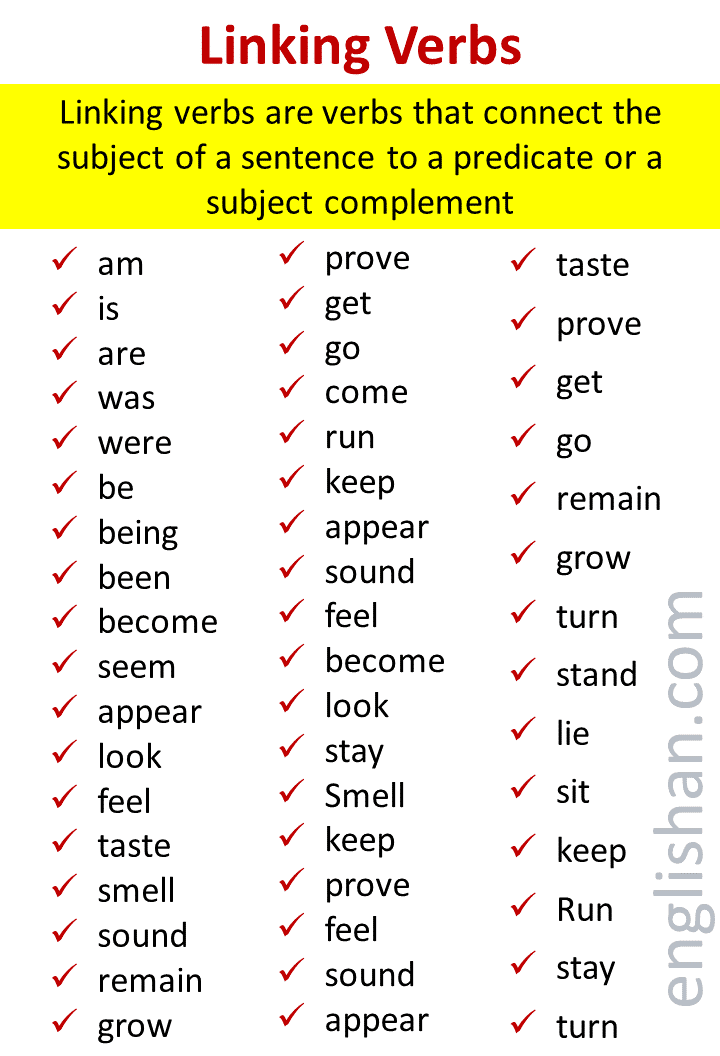
Helping Verbs
Helping verbs (or auxiliary verbs) are used with main verbs to indicate tense, voice, mood, or aspect. Common helping verbs include “be,” “do,” “have,” and modals like “will,” “can,” “should,” and “must.”
Common Helping Verbs and Their Functions
| Helping Verb | Function | Example |
|---|---|---|
| Be | Indicates continuous or passive voice | She is singing. (Present continuous) |
| Have | Forms perfect tenses | They have finished their homework. (Present perfect) |
| Will | Expresses future tense | He will be going to the party. (Future) |
| Should | Suggests obligation or advice | I should have studied more. (Past obligation) |
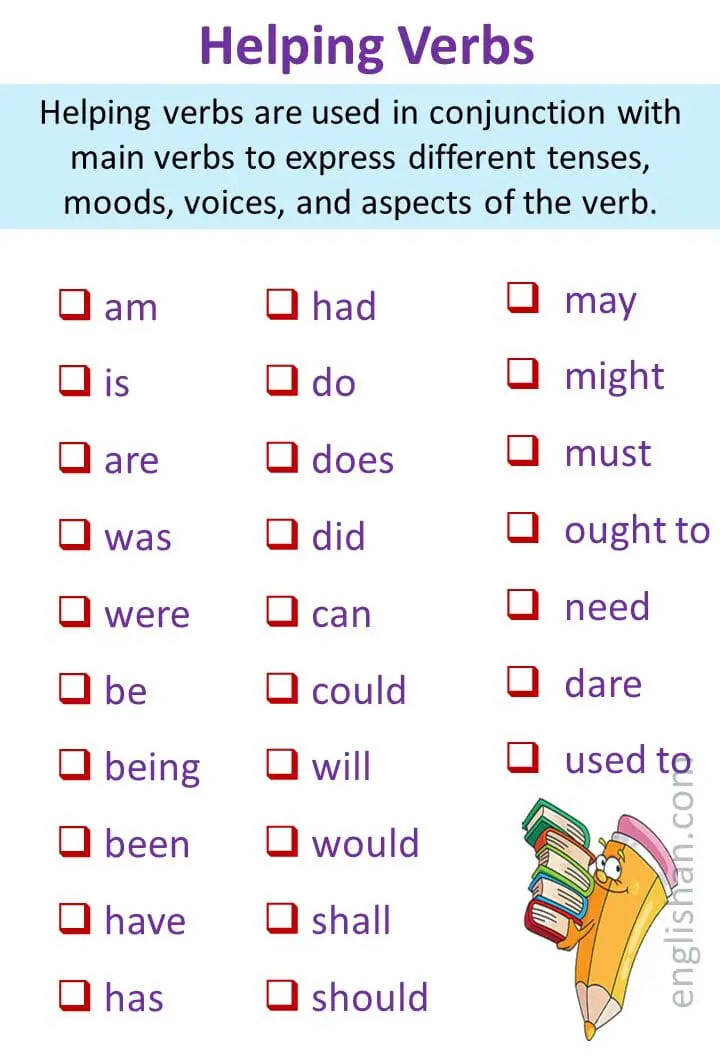
Modal Verbs
Modal verbs are auxiliary verbs that express the speaker’s attitude toward the action or state of the main verb. They convey meanings like ability, possibility, necessity, permission, advice, and preference.
Common Modal Verbs and Their Functions
| Modal Verb | Function | Examples |
|---|---|---|
| Can | Ability or possibility | I can swim. / It can rain today. |
| Could | Past ability or possibility | I could swim when I was younger. / It could have been worse. |
| May | Permission or possibility | May I borrow your pencil? / It may rain tomorrow. |
| Might | Possibility or uncertainty | He might come to the party. / I might take a nap. |
| Must | Necessity or obligation | I must finish my homework. / You must follow the rules. |
| Should | Advice or recommendation | You should study for the exam. / We should go to bed early. |
| Would | Willingness or preference | I would like some tea. / Would you mind helping me? |
Modal verbs are essential in English as they help convey different modalities, making sentences clearer and more specific. Understanding the use of modal verbs enriches communication.
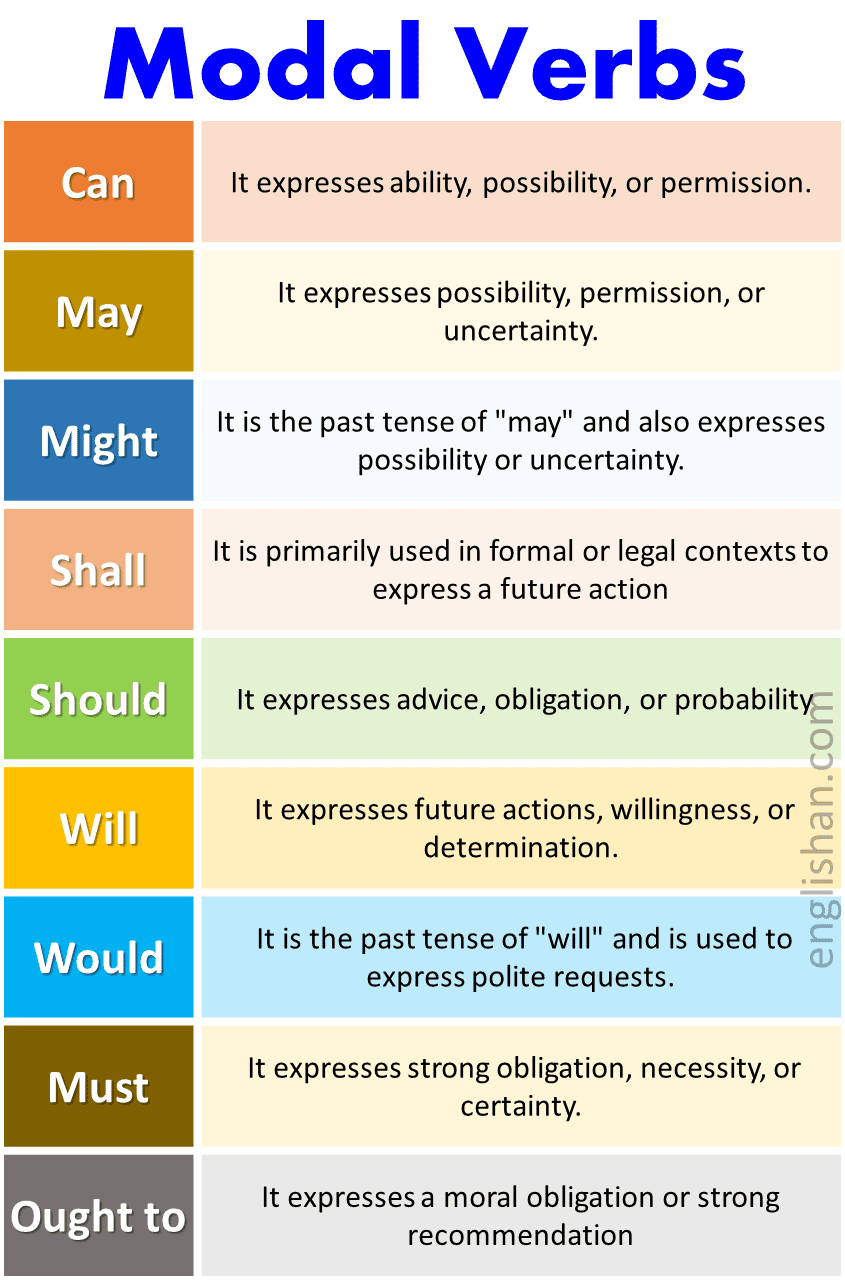
Transitive verbs
Transitive verbs are action verbs that require a direct object to complete their meaning in a sentence. The direct object receives the action performed by the subject.
Examples of Transitive Verbs in Sentences
- He threw the ball.
- She ate the sandwich.
- They built a house.
- I wrote a letter.
- The dog chased the cat.
Without a direct object, the meaning of a transitive verb is incomplete. Transitive verbs are essential in expressing actions that are performed on specific objects.
Common Transitive Verbs
- Write, Read, Eat, Drink, Cook
- Paint, Draw, Play, Throw, Catch
- Build, Use, Buy, Sell, Wear
Understanding transitive and intransitive verbs helps clarify whether a verb requires a direct object to complete its meaning. This distinction is important for constructing accurate sentences.
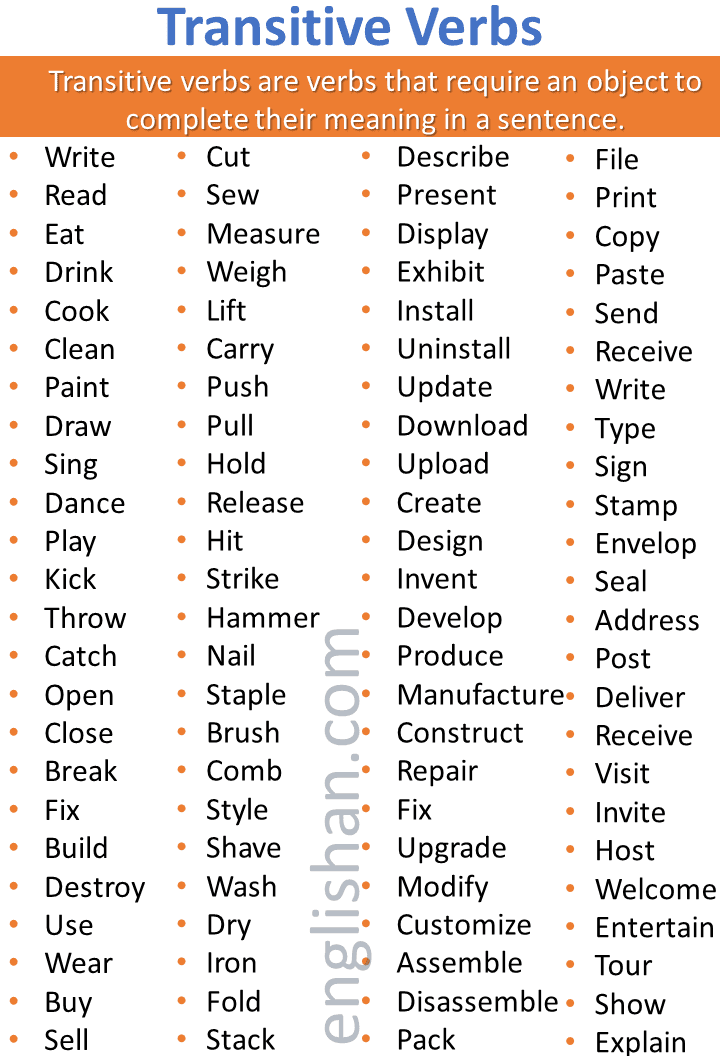
Intransitive verbs
Intransitive verbs are action verbs that don’t require a direct object to complete their meaning. They describe actions that stand alone, without transferring the action to something else. These verbs can be modified by adverbs or prepositional phrases but don’t have a direct recipient.
Examples of Intransitive Verbs in Sentences
- She laughed.
- The flowers bloomed.
- He ran quickly.
- The baby slept peacefully.
- The bird flew away.
Common Intransitive Verbs
- Run
- Sleep
- Laugh
- Cry
- Sing
- Dance
- Jump
- Walk
- Fly
- Arrive
- Fall
- Shine
- Melt
- Freeze
- Explode
- Collapse
These verbs may be followed by adverbs or prepositional phrases that describe the action, but they do not require an object. For example, “He ran quickly” uses the adverb “quickly” to modify the verb “ran.”
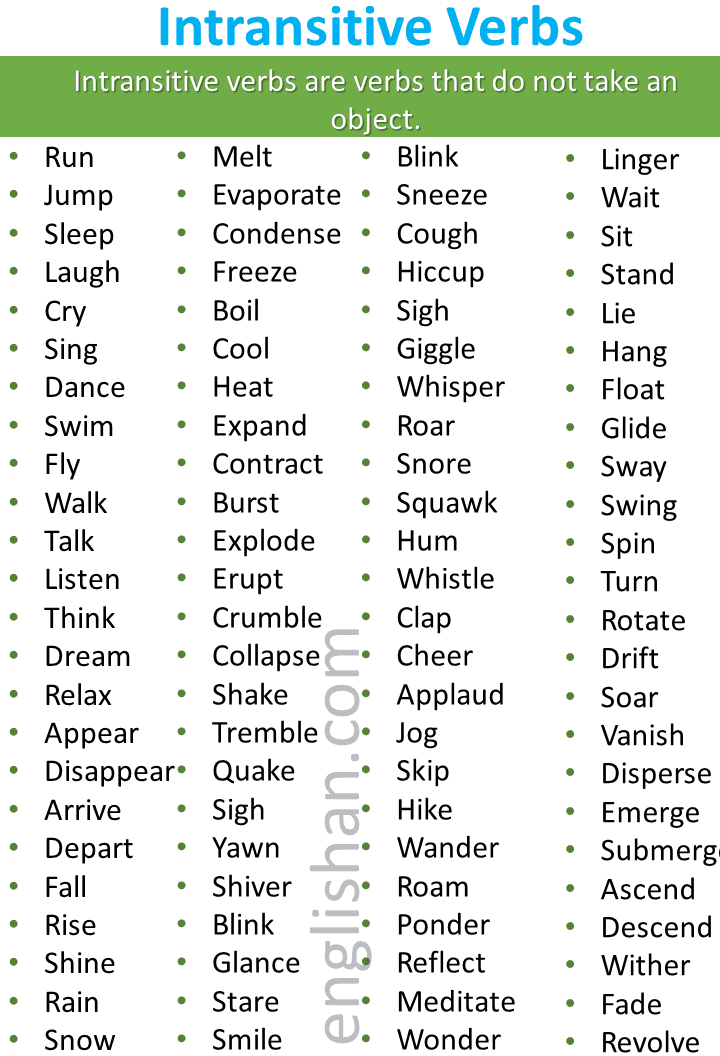
Phrasal verbs
Phrasal verbs are verbs combined with one or more particles (prepositions or adverbs) that create a unique meaning, often different from the base verb.
Types of Phrasal Verbs
Phrasal verbs are verbs combined with particles (prepositions or adverbs) that create unique meanings. Some phrasal verbs are separable and inseparable phrasal verbs, depending on whether the object can be placed between the verb and particle or must follow the particle directly. Understanding this distinction helps in using these verbs correctly in sentences.
- Separable: The object can be placed between the verb and the particle or after the particle.
- Example: “Turn off the lights” or “Turn the lights off.”
- Inseparable: The object must always follow the particle.
- Example: “Look after the children.”
Knowing whether a phrasal verb is separable or inseparable helps in using it correctly in sentences.

Regular Verb
A regular verb is a verb that forms its past tense and past participle by adding “-ed” to the base form of the verb. For example, the verb “walk” is a regular verb. Its past tense and past participle are formed by adding “-ed” to the base form, resulting in “walked.” Other examples of regular verbs include “talk,” “play,” “smile,” “laugh,” “work,” and “clean.”
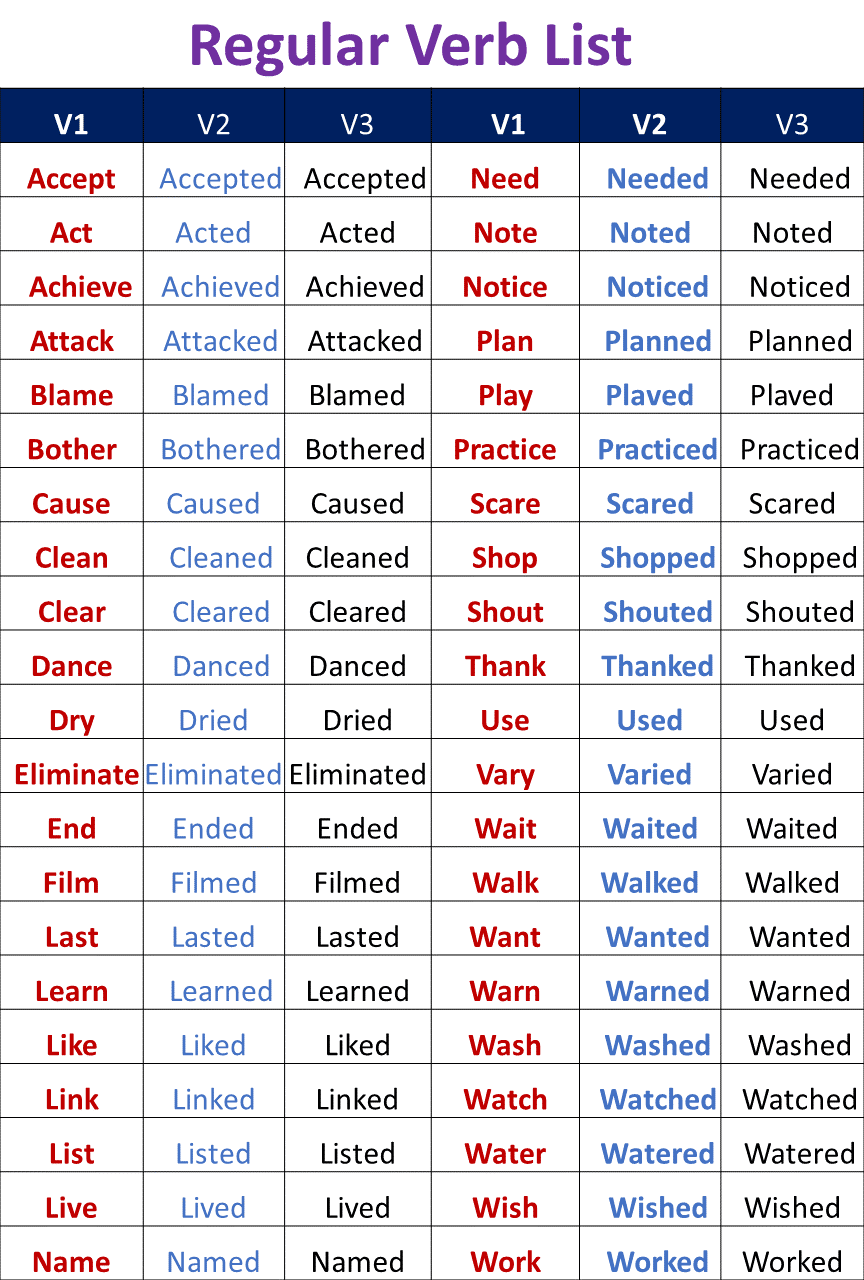
Irregular Verb
An irregular verb does not form its past tense by simply adding “-ed” like regular verbs. Instead, it changes in various ways, such as altering vowel sounds or keeping the same form.
Examples:
- go → went, gone
- eat → ate, eaten
- see → saw, seen
- run → ran, run
Since irregular verbs don’t follow standard patterns, it’s important to memorize their forms.
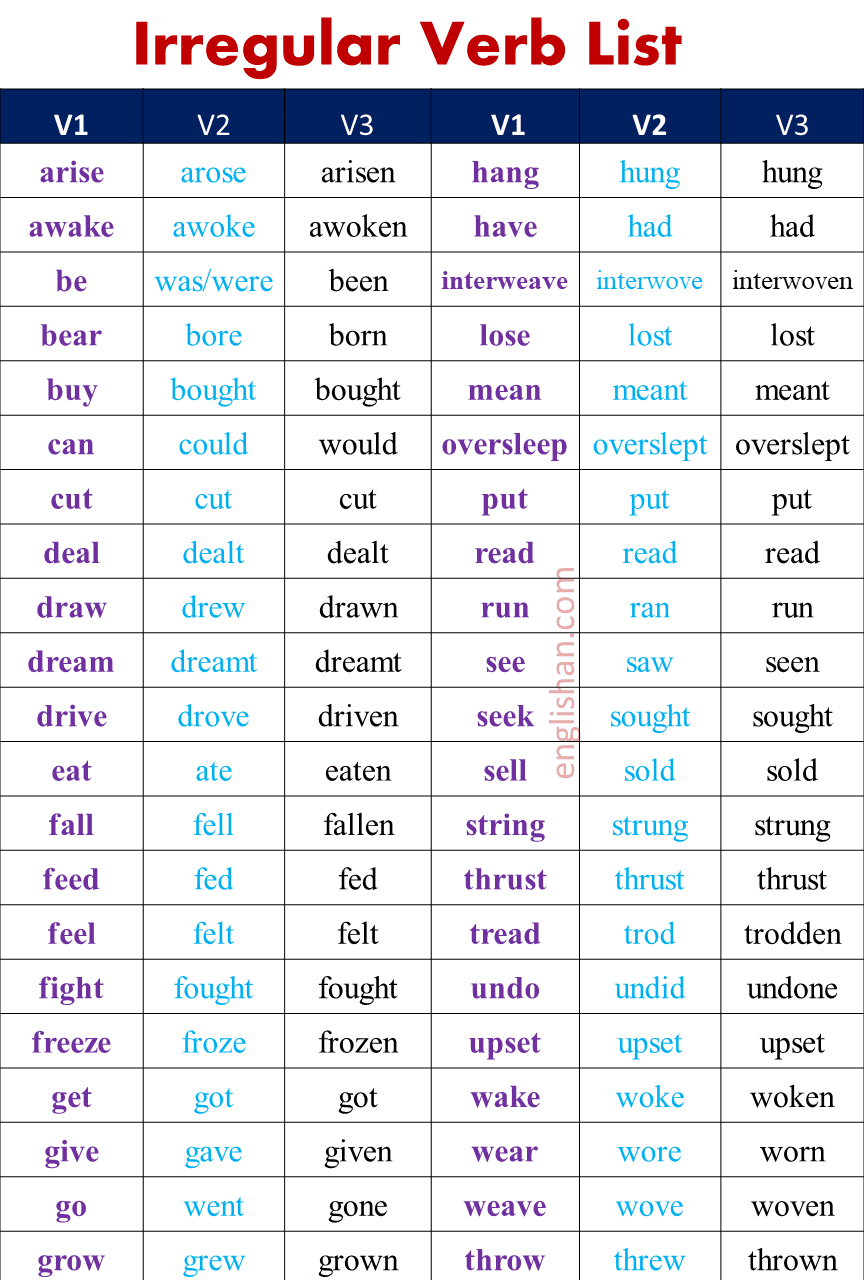
Stative Verb
A stative verb describes a state or condition rather than an action. These verbs often refer to mental or emotional states, physical sensations, or characteristics of a person or thing. Stative verbs are not usually used in continuous or progressive tenses.
Examples:
- love, hate, believe
- know, own, seem
- appear, weigh, feel
Since stative verbs express non-actions, they are often paired with verbs like “be” or “have” and typically don’t appear in forms like “loving” or “knowing.”
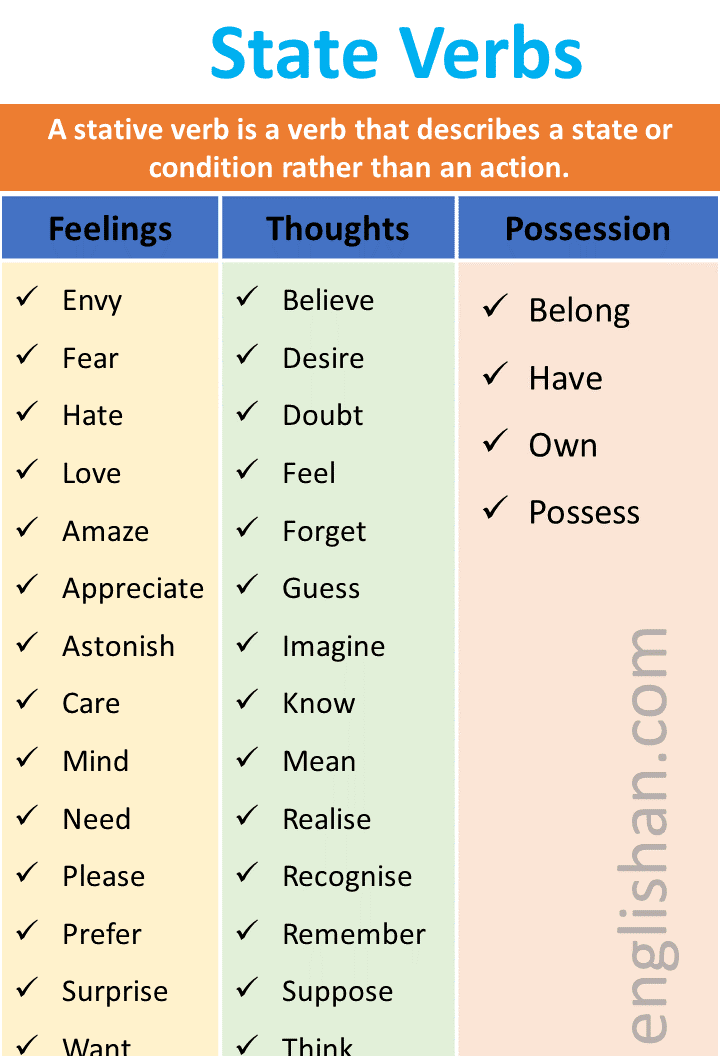
Finite Verb
A finite verb is a verb that shows tense, mood, and agrees with its subject. It indicates when an action happens and who performs it. For instance, in “She walks to school,” “walks” is a finite verb because it’s in the present tense and agrees with the subject “she.”
Non-finite verbs, on the other hand, don’t change according to tense or subject. These include infinitives (to walk), gerunds (walking), and participles (walked). Non-finite verbs don’t act as the main verb in a sentence. Understanding these types of verbs is essential for identifying the main action in a sentence and structuring sentences correctly.
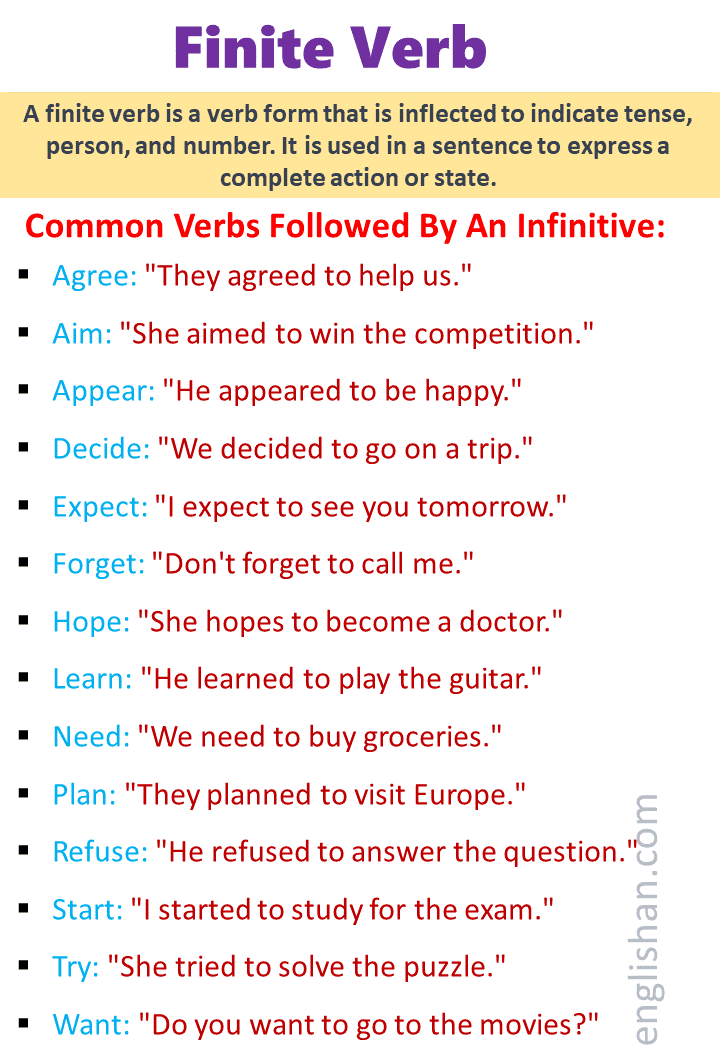
Infinite Verb
An infinite verb is a non-finite verb that is not bound by tense, mood, or subject agreement. It does not show when an action happens or who performs it.
Types of Infinite Verbs:
- Infinitive: The base form of a verb, usually preceded by “to” (e.g., “to walk,” “to eat”). It is often used as the subject, object, or after verbs like “want” or “need.”
- Gerund: A verb ending in “-ing” that functions as a noun (e.g., “walking,” “talking”). Gerunds can be the subject or object of a sentence or follow prepositions.
- Participle: Verb forms that act as adjectives or help form verb tenses. Present participles end in “-ing” (e.g., “walking”), while past participles often end in “-ed” (e.g., “walked”). Participles are used in tenses like the present continuous (“She is walking”) or past perfect (“He had walked”).
These forms of non-finite verbs are important for creating varied and complex sentences.
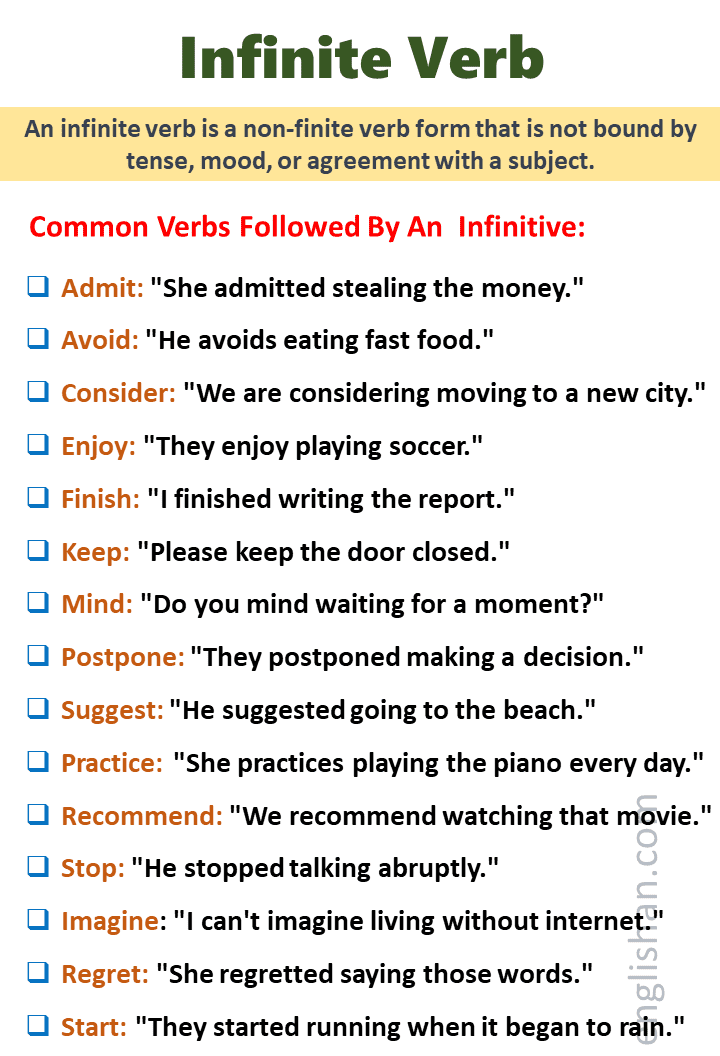
Common Verb List
| Walk | Illustrate | Acquire |
| Doubt | Advise | Criticize |
| Start | Steal | Invest |
| Restore | Paint | Assure |
| Sleep | Stop | Deduct |
| Retain | Belong | Prefer |
| Integrate | Retain | Postpone |
| Communicate | Integrate | Achieve |
| Pursue | Communicate | Climb |
| Chop | Drill | Drink |
| Hurry | Must | Behave |
| Cling | Decide | Feel |
| Mind | Might | Recall |
| Hate | Push | Whip |
| Comprehend | Enhance | Attribute |
| Lay | Derive | Reflect |
| Allocate | Occupy | Open |
| Survey | Point | Risk |
| Prepare | Perceive | Wake |
| Arise | Appreciate | Claim |
| Apply | Indicate | Come |
| Plan | Involve | Eat |
| Arrive | Consult | Imply |
| Seem | Spend | Struggle |
| Enjoy | Stack | Contradict |
| Locate | Slice | Regret |
| Compensate | Owe | Bring |
| Sting | Reverse | Stir |
| Demand | Spill | Delay |
| Should | Sink | Intervene |
| Fit | Win | Drive |
| Fry | Consume | Include |
| Learn | Retire | Breed |
| Shed | Contain | Explore |
| Determine | Expand | Generate |
| Fall | Spit | Forget |
| Modify | Replace | Legislate |
| Propose | Warn | Slide |
| Dare | React | Rely |
| Wash | Astonish | Blow |
| Inhibit | Submit | Emphasize |
| Avoid | Like | Specify |
| Wait | Argue | Realize |
| Bow | Analyze | Pull |
| Hear | Assume | Adjust |
| Leap | Shine | Function |
| Restrict | Translate | Begin |
| Announce | Receive | Volunteer |
| Compound | Feed | Participate |
| Slip | Mention | Wish |
| Investigate | Set | Grow |
| Expect | Squat | Scrub |
| Pay | Depend | Interact |
| Observe | Monitor | Refer |
| Reinforce | Identify | Tiptoe |
| Matter | Beg | Alternate |
| Evaluate | Spell | Recommend |
| Require | Hug | Prioritize |
| Measure | Order | Relieve |
| Desire | Remember | Justify |
| Pinch | Give | Facilitate |
| Compete | Dance | Conduct |
| Promote | Affect | Bet |
| Calculate | Concern | Channel |
| Ring | Hit | Stink |
| Link | Comprise | Mean |
| Add | Attract | Care |
| Create | Relax | Exist |
| Imagine | Get | Refuse |
| Miss | Light | Inform |
| Manage | Write | Buy |
| Lie (not to tell the truth) | Prevent | Drink |
| Deliver | Get | Fail |
| Process | Throw | Sit |
| Bend | Break | Validate |
| Transfer | Experiment | Kiss |
| Overtake | Spread | Prove |
| Ride | Practice | Insist |
| Aid | Recollect | Possess |
| Follow | Bind | Incorporate |
| Consider | Install | Ask |
| Would | Discover | Guide |
| Wave | Confine | Obtain |
| Demonstrate | Rid | Deviate |
| Consent | Attempt | Attain |
| Convince | Can/could | Attach |
| Swing | Repair | Build |
| Impose | Read | Ski |
| State | Vary | Supply |
| Promise | Maintain | Tell |
| Proceed | Improve | Deal |
FAQs
Verbs are action or state words. There are four main types:
1. Action Verbs: Show actions. She runs.
2. Linking Verbs: Connect the subject to information. He is happy.
3. Helping Verbs: Help main verbs. She is singing.
4. Modal Verbs: Show ability or possibility. I can swim.
These types make sentences clear and meaningful!
There are 8 types of verbs based on their roles in sentences.
Here are the 8 types of verbs with simple examples:
1. Action Verbs: Show actions. She runs.
2. Transitive Verbs: Need an object. He kicked the ball.
3. Intransitive Verbs: Don’t need an object. She sleeps.
4. Linking Verbs: Connect the subject to information. He is happy.
5. Helping Verbs: Help the main verb. She is singing.
6. Modal Verbs: Show ability or possibility. I can swim.
7. Regular Verbs: Follow a pattern (e.g., play → played).
8. Irregular Verbs: Don’t follow a pattern (e.g., go → went).
These make sentences clear and complete!
Here are the 3 types of verbs:
1. Action Verbs: Show what someone does.
She runs fast.
2. Linking Verbs: Connect the subject to more information.
He is happy.
3. Helping Verbs: Help the main verb show time or meaning.
She is singing.
These verbs make sentences meaningful!
Here are the 7 types of verbs with simple examples:
1. Action Verbs: Show what someone does.
She runs.
2. Transitive Verbs: Need an object.
He kicked the ball.
3. Intransitive Verbs: Don’t need an object.
She sleeps.
4. Linking Verbs: Connect the subject to more information.
He is tall.
5. Helping Verbs: Help the main verb.
She is eating.
6. Modal Verbs: Show ability or possibility.
I can swim.
7. Auxiliary Verbs: Help the main verb with time or meaning.
They have finished.
These types make sentences clear!
You May Also Like

